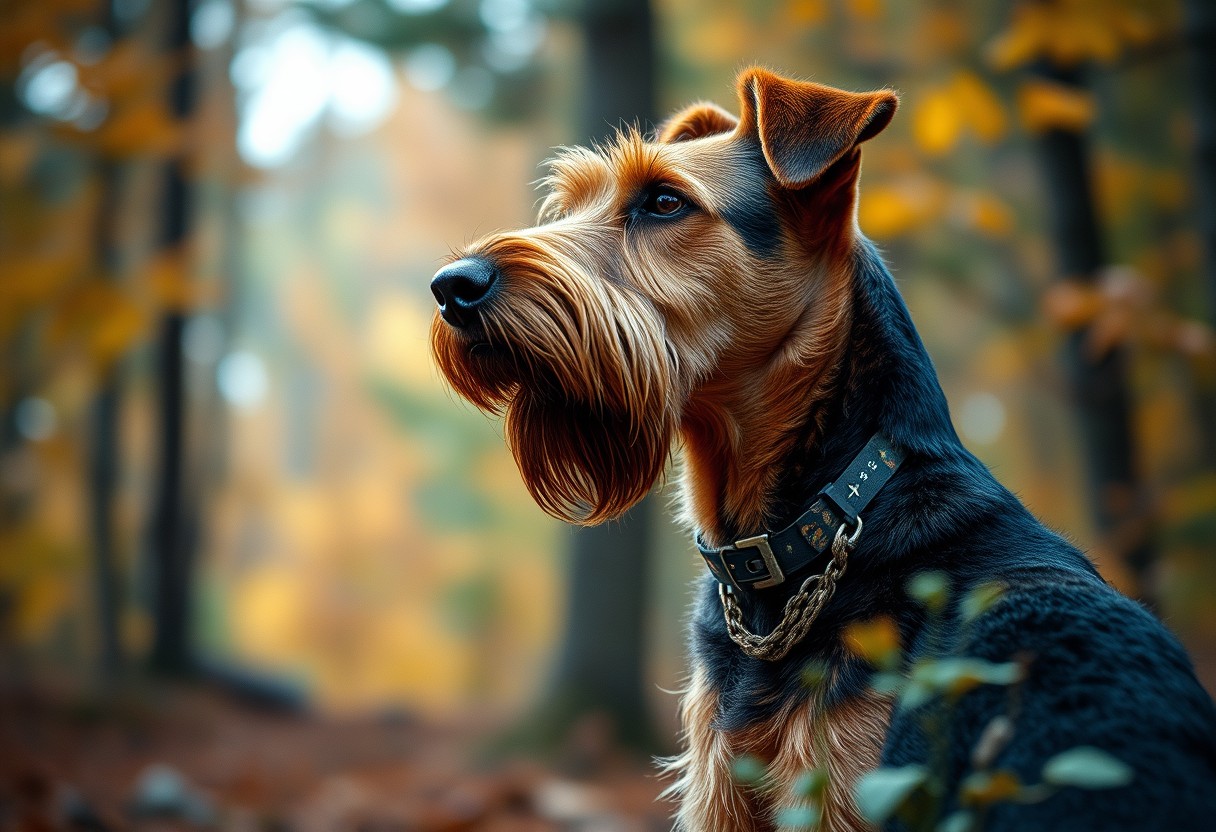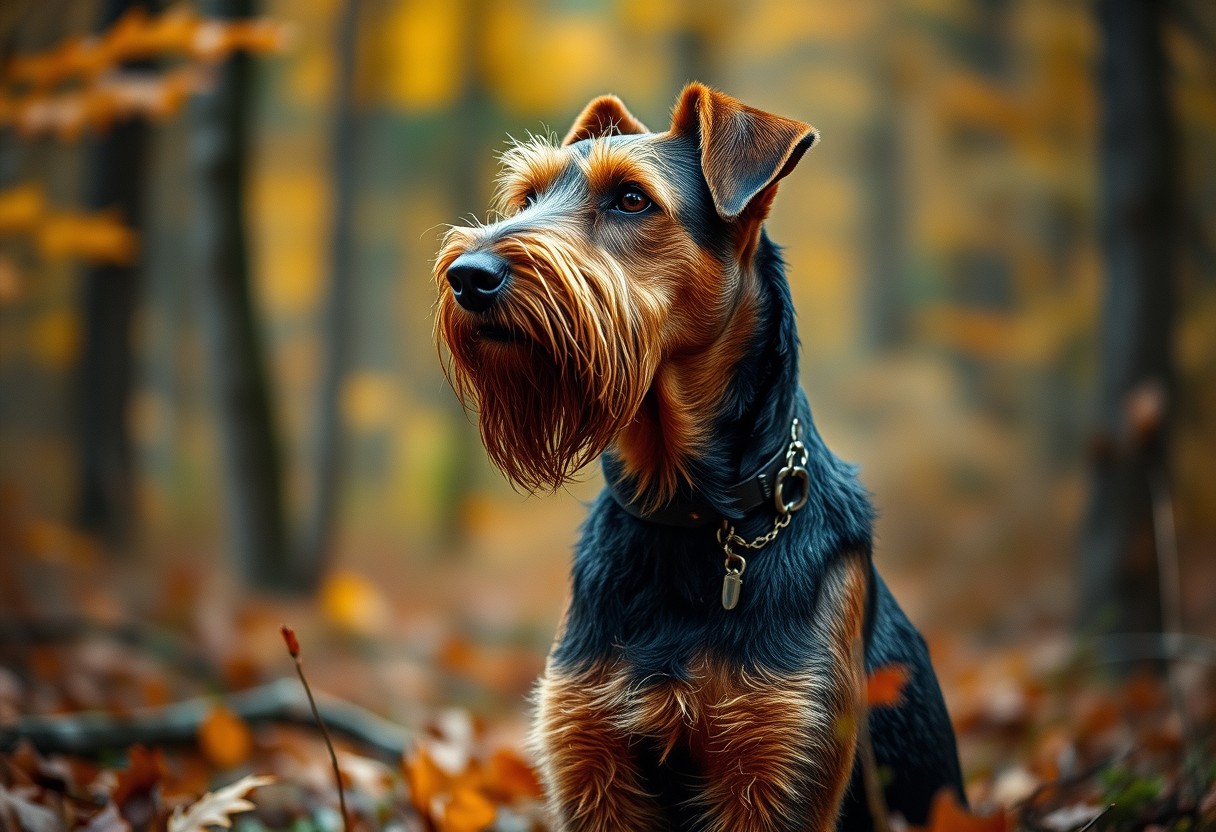Airedale Terrier Bear Hunting – Is It Possible?

Most people associate Airedale Terriers with being friendly family pets, but their history reveals a surprising potential for bear hunting. While these intelligent, versatile dogs were originally bred for hunting small game, you may wonder if they have what it takes to tackle larger predators like bears. In this blog post, we will explore the capabilities and challenges of using Airedales in bear hunting, helping you determine if it’s a viable option for your hunting endeavors.
Understanding Airedale Terriers
Breed Characteristics
Characteristics of the Airedale Terrier and its athletics set it apart from other breeds. Known as the “King of Terriers,” this breed is the largest of the terrier family, typically weighing between 40 to 65 pounds. With a distinctive coat that features a hard, wiry outer layer and a soft undercoat, the Airedale is well-equipped to handle various weather conditions. Their broad skull and long, flat back give them a robust appearance, while their intelligence and keen senses make them competent working dogs. This breed’s stamina and agility further enhance its capabilities, which is crucial if you ever consider using them for tasks like bear hunting.
Airedales are also known for their energetic nature and versatility, which means they thrive on physical activity and mental stimulation. It’s imperative to provide ample exercise and engaging activities to keep them happy and healthy. As a breed that initially served as a hunting dog, they have an instinctive drive that can be quite beneficial in certain situations, but it can also pose challenges if not managed appropriately.
History of the Airedale Terrier
Breed history reveals that the Airedale Terrier originated in the Aire Valley of Yorkshire, England, during the 19th century. Originally bred to catch otters and rats in the region, this breed has evolved alongside humans in various roles, from service dogs to loyal companions. The combination of working prowess and affectionate temperament has attributed to their popularity over the years. With roots in various terrier types, the Airedale has maintained its unique characteristics through careful breeding.
Another interesting facet of Airedale Terrier history involves their use in World War I, where they served as messenger dogs, sentry dogs, and even ambulance dogs, demonstrating their intelligence and trainability. This rich history highlights their capability to adapt to different roles while maintaining an unwavering loyalty to their handlers, creating a strong bond that lasts throughout their lives.
Temperament and Personality
To understand the temperament and personality of Airedale Terriers is vital when considering them as potential companions or working dogs. Generally, Airedales are known to be confident, friendly, and protective. Their inherent nature makes them excellent family pets as well as watchdogs, allowing them to blend well into various home environments. However, you must be aware that they can sometimes exhibit a stubborn streak, which means that early training and socialization are key to ensuring a well-adjusted adult dog.
Personality traits of the Airedale make them both charming and demanding. These dogs are high-energy and require regular exercise and mental challenges to keep them content. If you provide consistent training and plenty of engagement, your Airedale will reward you with a devoted friendship. It’s important to remember, though, that their bold nature means they can be assertive, which may lead to unwanted behaviors if not properly guided.
Bear Hunting: An Overview
Little do many know, bear hunting can be an exhilarating challenge that requires extensive knowledge of both wildlife and regulations. Airedale Terriers, with their history as versatile working dogs, may seem like unconventional choices for such an endeavor. However, understanding the different types of bear species and the heart of their habitats can give you insight into whether this breed can effectively assist in the hunting process.
Types of Bear Species
With various bear species populating different regions, it is crucial to recognize their unique habits and characteristics. Some of the most common species you might encounter include:
| Bear Species | Characteristics |
|---|---|
| American Black Bear | Highly adaptable, primarily foraging for food, and generally non-aggressive unless provoked. |
| Grizzly Bear | Larger and more powerful, they can be territorial, especially when cubs are present. |
| Panda Bear | A primarily herbivorous species known for being non-aggressive but still very large. |
| Polar Bear | The largest land carnivore, often found in cold regions with a strong predatory instinct. |
| Asiatic Black Bear | Also known as moon bears, these bears are agile climbers and primarily solitary. |
The diversity among bear species brings unique challenges and opportunities when considering your Airedale Terrier for hunting assistance.
Legal Aspects of Bear Hunting
Species conservation and regulations are critical components of a successful bear hunting trip. Before you initiate on any such adventure, you must familiarize yourself with the local and federal laws governing bear hunting in your area. Each species has specific hunting seasons, quotas, and methods that you must adhere to, ensuring that the population remains sustainable throughout the years.
To hunt bears legally, you need to ensure that you possess the proper licenses and tags, which vary from one region to another. Furthermore, abiding by the rules surrounding bear hunting not only preserves wildlife but also protects you from legal consequences. Therefore, thorough research about the hunting regulations in your area is a non-negotiable step in your planning process.
Hunting Techniques and Strategies
Overview of hunting techniques plays a significant role in how successful your hunt will be. The familiarization with your environment, tracking methods, and utilizing resources effectively will help improve your chances of a successful hunt. Common strategies for bear hunting include baiting, spot-and-stalk, and hunting with dogs, each offering its unique benefits and challenges.
Hunting with your Airedale Terrier may involve innovative techniques tailored to the dog’s traits. Utilizing the dog’s keen sense of smell and agility can provide you with a strategic advantage during the hunt. Developing a clear communication system with your dog ensures that both of you remain coordinated, leading to an effective and exhilarating hunting experience.

The Airedale’s Hunting Instincts
Unlike many other breeds, Airedale Terriers possess a set of innate hunting instincts that can make them quite adept at tracking and hunting. Their background as versatile working dogs has equipped them with a keen sense of smell and an energetic disposition, which are critical traits for any hunting endeavor. When considering hunting larger game, such as bears, understanding these instincts is not only fascinating but important for assessing the breed’s capabilities in such high-stakes scenarios.
Natural Hunting Abilities
To explore the natural hunting abilities of the Airedale Terrier, it’s important to recognize their lineage. Originally developed in England for catching otters and rats, Airedales have a natural drive to pursue and retrieve game. Their strong prey drive and ability to work independently make them suitable for various hunting tasks. However, hunting large game like bears requires more than just enthusiasm; it demands careful consideration of strength, stamina, and instinct.
To fully utilize their potential, you must engage Airedales in consistent exercises and drills that hone their instincts. This can include tracking scents, retrieves, and establishing boundaries. Many owners find that Airedales respond well to challenges, which can strengthen their hunting abilities. However, a healthy respect for the potential dangers involved in bear hunting is crucial, as their confidence can sometimes border on recklessness.
Comparisons with Other Hunting Breeds
Hunting is a term that encompasses a wide array of breeds, each with unique skills tailored to specific types of game. The following table compares the Airedale Terrier with other popular hunting breeds:
Comparison of Hunting Breeds
| Feature | Airedale Terrier |
| Size | Large |
| Prey Drive | Strong |
| Training Sensitivity | High |
| Stamina | Moderate to High |
| Suitability for Bear Hunting | Debatable |
Another breed comparison reveals that breeds like the Labrador Retriever or German Shorthaired Pointer are often favored for hunting larger game due to their physical strength and unmatched endurance. These breeds not only possess a similar strong prey drive but are also built with muscle mass and stamina that can withstand the rigors of bear hunting. In contrast, the Airedale, while intelligent and strong in its own right, may lack the sheer physical capacity required for handling larger game effectively.
Training for Game Hunting
Breeds designed for hunting often have specific training needs, and Airedales are no exception. Training your Airedale for game hunting necessitates structured routines, including obedience training, scent work, and socialization. This kind of comprehensive training helps channel their natural hunting instincts into productive behaviors. Additionally, utilizing a variety of training techniques can better equip your Airedale for outdoor challenges. Building a rapport with your dog through positive reinforcement can also deepen your working relationship.
This approach to training not only improves your Airedale’s hunting instincts but can also make the process enjoyable and rewarding for both of you. Remember that patience and consistence are vital; a well-trained Airedale Terrier is likely to become an invaluable hunting companion. Nevertheless, always be mindful of your Airedale’s limitations and gradually progress through training stages to ensure a safe and productive hunting experience.
Preparing for Bear Hunting with Airedales
All preparation for bear hunting with Airedale Terriers should be taken seriously, as both the dogs and the hunters face unique challenges in the wilderness. Proper training, fitness, and gear are critical. Investing time in conditioning your Airedale will enhance their ability to track and confront large game, such as bears. Additionally, you need to ensure that both you and your dog are in top shape for the demands that bear hunting presents.
Fitness and Health Requirements
For Airedale Terriers, maintaining excellent physical condition is paramount when preparing for bear hunting. You should focus on ensuring your dog gets adequate exercise leading up to the hunt, including long walks, agility training, and endurance runs. This will not only help your Airedale develop muscle tone and stamina, but it will also keep their weight in check, which is crucial for efficient movement in rugged terrain.
In addition to physical fitness, it is crucial to consult with a veterinarian to confirm that your dog is fit for the task at hand. Regular vaccinations, flea and tick preventatives, and appropriate dietary needs should all be addressed prior to your journey. A well-prepared dog is less likely to face health issues or injuries during the hunt, and ensuring their health is a direct reflection of your commitment to the experience.
Equipment and Gear Needed
On the bear hunting trip, you must equip your Airedale with the right gear to ensure their safety and performance. Essential items include a durable collar, a strong leash, and a high-quality harness designed for pulling. Consider investing in a tracking collar, as this will allow you to monitor your dog’s location during the hunt, especially in the dense forests where bears are commonly found.
Another crucial aspect of preparing for bear hunting with Airedales is to consider clothing and safety provisions for both you and your dog. Protective vests can help shield your Airedale from rough terrain and potential hazards, while booties will protect their paws from sharp objects. For yourself, carry bear spray, noise-making devices, and a strategic first aid kit, as these items are vital for both your and your dog’s safety in the wilderness.
Pack Behavior and Social Structure
Airedales are known for their strong pack instincts and social behaviors. Understanding your dog’s place within the social structure can play a significant role in successful bear hunting. You should establish yourself as the leader, as dogs are more likely to obey commands when they respect your authority. This relationship fosters teamwork during the hunt, allowing for better coordination when tracking and confronting bears.
Structure is crucial for effective pack behavior. Airedales thrive in situations where they have a clear understanding of their roles. When in the field, your dog needs to know when to be alert and when to act. Providing consistent training and positive reinforcement can help create a well-functioning hunting unit. The bond that develops through this training can lead to a heightened performance when facing the challenges of bear hunting, ensuring both your safety and the success of the hunt.

Risks and Challenges of Airedale Bear Hunting
For anyone considering using an Airedale Terrier for bear hunting, it is crucial to recognize the inherent risks and challenges involved in this endeavor. While Airedales are known for their intelligence, agility, and keen sense of smell, their size and temperament may not always align with the demands of bear hunting. Understanding these risks will help you make informed decisions regarding the suitability of this breed for such a task.
Safety Concerns for Dogs
To ensure the safety of your Airedale during bear hunting, you must take several precautions. First and foremost, it’s crucial to assess your dog’s physical capabilities and temperament. Airedales are robust, but their strength might not be adequate to confront a bear directly. Proper training and experience are crucial; without this, your dog could easily find itself in a perilous situation, which could jeopardize its safety.
Additionally, consider the potential for injury in rough terrain. You must equip your Airedale with protective gear, such as padded collars and boots, to shield against sharp objects and rough ground. Keeping your dog leashed and under supervision is vital to avoid unwanted confrontations with wildlife that could result in injury or death.
Potential Risks of Bear Encounters
Concerns inevitably arise when your Airedale encounters a bear. Bears are unpredictable creatures that can respond aggressively if they feel threatened. Even a situation that seems manageable can escalate quickly, posing serious risks not only to your dog but to you and your hunting party as well. Training your Airedale to recognize and give space to bears is critical; their instinct to protect or confront might inadvertently lead them into harm’s way.
Bear encounters can vary significantly in intensity. While some bears might choose to retreat, others may stand their ground or charge in defense. Each of these scenarios could lead to catastrophic outcomes if your Airedale does not heed your commands. Implementing safe practices and understanding bear behavior is crucial in mitigating these risks during your hunts.
Environmental Considerations
Environmental factors play a crucial role in Airedale bear hunting. Your dog’s performance and safety can be significantly influenced by the terrain, weather conditions, and the presence of other wildlife. It’s vital to assess the area for potential hazards, such as steep inclines, dense brush, and areas prone to flash floods. These elements can pose a risk to both you and your Airedale, making preparation and knowledge of the environment crucial.
Furthermore, be aware of the seasonal variations that can affect bear activity and your Airedale’s performance. Rain or snow can create slippery conditions, affecting your Airedale’s agility and, thus, its capacity for successful hunting. Animals sometimes change their patterns based on seasonal food availability, meaning you should plan your hunting trips around these fluctuations to optimize safety and success.
Another important factor to consider is the potential presence of other wildlife in the area. Predators, such as wolves or coyotes, may pose a threat to your Airedale, especially if it is working alone. Understanding the ecological dynamics of your hunting area can help you make better choices regarding your dog’s safety and overall hunting strategy.
Success Stories and Testimonials
Keep in mind that while Airedale Terriers may not be the most common choice for bear hunting, many owners have shared their experiences that showcase the breed’s adaptability and courage. Through rigorous training and a strong bond with their handlers, these dogs have proven that their instincts can lead to successful hunts. Reports from Airedale owners indicate that, when properly supervised and conditioned, these dogs can contribute significantly to the hunt, demonstrating remarkable agility and trackability. Their intelligence and tenacity can make them a valuable asset when you’re out in the field.
Experiences from Airedale Owners
The testimonials from Airedale owners speak volumes about the breed’s potential in bear hunting scenarios. Many enthusiasts share stories of their dogs fearlessly confronting bears, showcasing an instinctual drive that goes beyond typical hunting. These accounts often highlight the importance of proper training and the unique relationship that you can build with your Airedale, which can further enhance the hunting experience. Owners emphasize how a strong handler-dog bond can lead to success, defeating the odds of stereotype and traditional hunting practices.
Notable Adventures in the Field
To illustrate the capabilities of Airedales in bear hunting, consider the experiences shared by seasoned hunters who have taken their Airedales into the wild. Many recount stories of their dogs picking up a bear’s scent and leading them through challenging terrain, which not only involves physical prowess but also remarkable mental acuity. The interaction between the Airedale and the bear often leads to exhilarating moments that are both heart-pounding and rewarding, reinforcing the connection that these dogs have with their handlers.
Success breeds confidence, and these adventure-filled moments serve as proof of the Airedale’s capabilities. It’s not uncommon to hear of Airedales successfully tracking and trailing bears for hours, demonstrating their unyielding determination and stamina. Owners who have participated in these hunts note the thrill of seeing their Airedales work harmoniously with their strategies, highlighting the breed’s adaptability on different terrains and weather conditions.
Expert Opinions on Breed Suitability
Any conversation surrounding the suitability of Airedale Terriers for bear hunting inevitably brings expert opinions to the forefront. While some professionals argue against using Airedales in such demanding hunts, others highlight their striking capabilities when the right circumstances and training are involved. Many point out that Airedales possess a unique combination of strength, stamina, and intelligence that can make them surprisingly effective, especially in dense foliage or rugged landscapes where larger breeds may struggle.
Field experts often note that understanding the temperamental needs of the breed is critical for successful outcomes. Airedales require socialization, containment, and consistent training to channel their natural instincts in a positive direction. Their ability to work well in teams, coupled with your guidance as a handler, can create a dynamic that leads to memorable and successful bear hunting experiences.
Training Tips and Techniques
After you decide to train your Airedale Terrier for bear hunting, it’s necessary to establish a solid foundation of skills and techniques. Success in the field relies heavily on proper training, which can be categorized into basic obedience, advanced hunting skills, and socialization with game animals. Each of these elements plays a significant role in developing a competent and cooperative hunting partner.
Basic Obedience Training
Basic training is critical for any hunting dog, including your Airedale Terrier. Prioritize commands such as sit, stay, come, and heel to ensure your dog can follow your lead in the field. Remember that consistency, patience, and positive reinforcement are vital components of effective training.
- Start training in a distraction-free environment.
- Use treats or praise to reward good behavior.
- Practice commands daily for short periods to maintain focus.
With consistent practice, your Airedale Terrier will become a well-mannered companion, making it easier to transition into more advanced skills required for bear hunting.
Advanced Hunting Skills
To prepare your Airedale Terrier for the specific challenges of bear hunting, you must focus on advanced skills that build upon the basic obedience foundation. This includes teaching your dog tracking, scenting, and retrieving skills that are crucial for hunting sturdy game like bears.
- Introduce scent work using bear scent or related training materials.
- Practice tracking games where your dog follows a scent trail.
- Implement retrieval exercises to reinforce bringing back a target.
Advanced Hunting Skills Breakdown
| Skill | Description |
| Scent Work | Encouraging your dog to identify and follow bear scents. |
| Tracking | Teaching your dog to follow trails left by game animals. |
| Retrieving | Training your dog to fetch items from the field. |
As you hone these skills, keep in mind that ongoing reinforcement and practice are necessary. A solid performance in advanced commands will significantly improve your Airedale Terrier’s effectiveness during bear hunts, as they will have the skills necessary to assist you competently.
- Utilize various environments to practice hunting skills.
- Enhance your dog’s physical condition with agility and endurance exercises.
- Gradually increase the complexity of tasks as your dog masters the basics.
Socialization with Game Animals
Socialization with Game Animals
Animals, especially when it comes to bear hunting, require your Airedale Terrier to be socialized with various game animals. Socialization helps your dog to recognize the difference between what’s a target and what’s not, thereby enhancing safety in the field. Start early by exposing your dog to controlled environments where game animals may be present, always ensuring it is done in a safe and controlled manner.
Consider introducing your Airedale Terrier to bait or decoy setups that mimic real-life situations. This strategy will assist your dog in learning how to behave around game animals without displaying excessive excitement or aggression, which is critical when hunting.
Training your Airedale Terrier for bear hunting requires dedication and a multifaceted approach. Each of these training components is necessary to ensure a successful and safe hunting experience.
Conclusion
Taking this into account, Airedale Terriers possess a unique set of skills that might make them suitable candidates for bear hunting under certain conditions. These dogs are known for their intelligence, versatility, and strong prey drive, which can be advantageous in tracking and flushing out game. However, it’s crucial to recognize that hunting bear poses significant dangers, not just for the bears but also for the hunters and their dogs. Ensuring that you are well-prepared, properly trained, and have a clear understanding of local laws and regulations surrounding bear hunting is necessary before considering an Airedale Terrier for this purpose.
Ultimately, if you are contemplating using an Airedale Terrier for bear hunting, you should weigh the benefits against the challenges. While they may excel in certain hunting scenarios, factors such as their size, temperament, and compatibility with other hunting dogs should be carefully evaluated. Your responsibility extends beyond hunting to ensuring the well-being and safety of your dog throughout the process. Always prioritize developing a strong bond with your Airedale Terrier, as this relationship will greatly influence their performance in the field, whether in bear hunting or other activities.
Check out these links for more information on Airedale Terriers and their potential in bear hunting:
- AKC – Airedale Terrier Breed Information
- PetMD – Airedale Terrier Overview
- The Spruce Pets – Airedale Terrier Care
- DogTime – Airedale Terrier Characteristics
- Hunting Dogs – Airedale Terrier and Bear Hunting
Q: Can Airedale Terriers be trained for bear hunting?
A: Yes, Airedale Terriers can be trained for bear hunting due to their intelligence, agility, and strong instinct to track and chase. They possess a natural affinity for working with humans and can be trained to work alongside hunters. However, it’s important to note that proper training and socialization are vital, as bear hunting requires a high level of control and discipline. Owners should seek guidance from experienced trainers who specialize in hunting dogs to ensure safety and effectiveness in the field.
Q: Are Airedale Terriers safe to use for bear hunting?
A: While Airedale Terriers are robust and courageous, using them for bear hunting poses significant risks. Bears are large and powerful animals, and even a determined Airedale may not have the strength or size to confront them effectively. It’s crucial for hunters to assess the dog’s capabilities and temperament before involving them in such dangerous activities. Protective measures should also be in place to ensure the safety of both the dog and the hunter during a bear hunt.
Q: What alternative roles can Airedale Terriers play in bear hunting if not as a primary hunting dog?
A: Airedale Terriers can serve as excellent tracking dogs or assist in locating bears rather than engaging them directly. Their keen sense of smell and ability to navigate varied terrains make them suitable for trailing bears and helping hunters identify bear activity. Additionally, they can also provide companionship and assist in scouting areas, contributing to the overall hunting experience without placing them in immediate danger.





